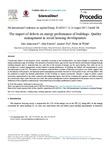The impact of defects on energy performance of buildings: Quality management in social housing developments
| dc.contributor.author | Alencastro, J | |
| dc.contributor.author | Fuertes, Alba | |
| dc.contributor.author | Fox, Andrew | |
| dc.contributor.author | de Wilde, Pieter | |
| dc.date.accessioned | 2019-03-21T10:30:58Z | |
| dc.date.issued | 2019-02 | |
| dc.identifier.issn | 1876-6102 | |
| dc.identifier.uri | http://hdl.handle.net/10026.1/13509 | |
| dc.description.abstract |
Construction defects in the domestic sector, especially occurring in the building fabric, are acknowledged to contribute to the energy performance gap of buildings. Discontinuity of insulation layers, gaps in the vapor/air barriers and thermal bridging through building elements lead to undesired heat loss, and thus to the increase of energy use for space heating. This study set out to investigate how quality management systems related to energy performance of buildings are defined and implemented in social housing projects in the UK. The analysis of evidence collected from a number of Housing Association case studies suggests that in the majority of the projects, the deployed quality management procedures focused on visual quality issues, allowing defects with the potential to impair the thermal performance of the dwellings to remain uncorrected. Despite a range of quality control procedures administered by the client, contractor and independent agents, they did not systematically appraise such defects during the construction stage. Apart from one case study, the quality management systems implemented in the projects lack an objective definition of the compliance methodology when addressing to the energy performance quality criteria. | |
| dc.format.extent | 4357-4362 | |
| dc.language | en | |
| dc.language.iso | en | |
| dc.publisher | Elsevier | |
| dc.subject | Energy efficiency | |
| dc.subject | building energy | |
| dc.subject | building regulations | |
| dc.subject | quality management | |
| dc.subject | defects | |
| dc.subject | social housing | |
| dc.title | The impact of defects on energy performance of buildings: Quality management in social housing developments | |
| dc.type | journal-article | |
| dc.type | Conference Proceeding | |
| plymouth.author-url | https://www.webofscience.com/api/gateway?GWVersion=2&SrcApp=PARTNER_APP&SrcAuth=LinksAMR&KeyUT=WOS:000471031704110&DestLinkType=FullRecord&DestApp=ALL_WOS&UsrCustomerID=11bb513d99f797142bcfeffcc58ea008 | |
| plymouth.volume | 158 | |
| plymouth.publication-status | Published | |
| plymouth.journal | Energy Procedia | |
| dc.identifier.doi | 10.1016/j.egypro.2019.01.784 | |
| plymouth.organisational-group | /Plymouth | |
| plymouth.organisational-group | /Plymouth/Faculty of Arts, Humanities and Business | |
| plymouth.organisational-group | /Plymouth/Faculty of Arts, Humanities and Business/School of Art, Design and Architecture | |
| plymouth.organisational-group | /Plymouth/Faculty of Science and Engineering | |
| plymouth.organisational-group | /Plymouth/REF 2021 Researchers by UoA | |
| plymouth.organisational-group | /Plymouth/REF 2021 Researchers by UoA/UoA13 Architecture, Built Environment and Planning | |
| plymouth.organisational-group | /Plymouth/Research Groups | |
| plymouth.organisational-group | /Plymouth/Research Groups/Marine Institute | |
| plymouth.organisational-group | /Plymouth/Users by role | |
| plymouth.organisational-group | /Plymouth/Users by role/Academics | |
| dcterms.dateAccepted | 2019-02-01 | |
| dc.rights.embargodate | 2019-3-22 | |
| dc.rights.embargoperiod | Not known | |
| rioxxterms.versionofrecord | 10.1016/j.egypro.2019.01.784 | |
| rioxxterms.licenseref.uri | http://www.rioxx.net/licenses/all-rights-reserved | |
| rioxxterms.licenseref.startdate | 2019-02 | |
| rioxxterms.type | Journal Article/Review |


